How to calculate the THC dose of edibles
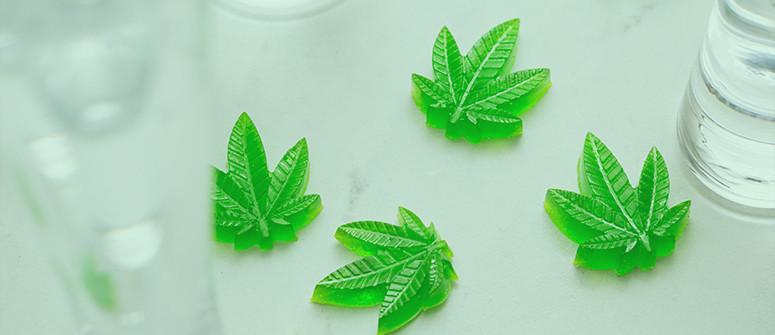
About to chow down on some weed brownies or cookies? Read this article first to ensure you know how to achieve the right dose and enjoy a positive experience, every time.
Contents:
Most people have either lived through a horrible experience with cannabis edibles or know someone who has. Because of their unique way of delivering cannabinoids into the body, edibles can produce intense, long-lasting effects that can be overwhelming for some people. Hence, properly dosing your edibles is key to an enjoyable experience.
In this article, we'll explore the ins and outs of dosing cannabis edibles, and show you why edibles hit so much harder than smoked or vaped weed.
Edible doses: A general overview
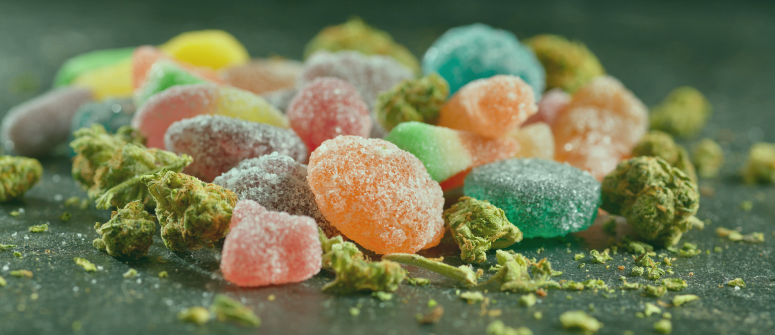
Before we dive deeper into the technicalities of dosing cannabis edibles, it helps to have a general understanding of different edible dose ranges and the effects they can produce.
Edible doses are measured in milligrams (mg) of tetrahydrocannabinol (THC). In most legal cannabis markets, a standard edible dose is considered to contain around 10mg of THC, but this can vary from region to region. Below is a general breakdown of micro, low, moderate, high, acute, and macro edible dose ranges, and the effects they may produce:
- Microdose (1–2.5mg): Microdoses of THC don't produce intoxicating effects. They may, however, produce holistic effects that subtly soothe the mind and body. Microdoses are popular among medical patients looking to relieve symptoms during the workday, as well as recreational users seeking a mild boost.
- Low dose (3–5mg): Low doses of edibles usually produce a high feeling in inexperienced cannabis users or those with a low tolerance. If you're new to weed, a 3–5mg dose might leave you feeling relaxed and uplifted, happy, giggly, and social (depending on the strain). Experienced cannabis users with a tolerance for THC, however, will experience a light buzz at best. Medical patients often find that 3–5mg doses help to address symptoms while only producing moderate intoxicating effects.
- Standard dose (10–15mg): This dose range is generally the starting point for experienced cannabis users and produces a very notable high/stone. Inexperienced users may find the length and intensity of a standard edible dose overwhelming, and are recommended to start with a lower dose.
- High dose (20–30mg): High-dose edibles are best reserved for experienced cannabis users who are very familiar with THC and have a high tolerance for its effects. They are not recommended for novices, as they produce intense effects that can result in strong euphoria, deep physical sedation, perceptual changes, and more. Medical cannabis users with chronic conditions may use doses of this size to address all manner of symptoms. If you are a medical marijuana patient and believe you might benefit from medicating with high-dose edibles, talk to your physician.
- Acute dose (50–100mg): Such high edible doses are usually only reserved for medical cannabis users dealing with severe symptoms and illnesses. At these concentrations, THC can long-lasting intoxication that may affect the emotions and mental health of inexperienced users or people with mental health issues. Always consult with a doctor before taking doses of this size.
- Macrodose (100–500mg): These extremely high doses are typically used by medical patients who have problems properly absorbing THC. They should not be taken recreationally, as they can produce side effects that are very unpleasant.
A note on the risks of high THC doses
Above we've described some extremely high doses of THC that can be found in edibles like those sold in legal cannabis markets. It is really important to understand that while these products are available legally in some places, or can be made at home, they pose some serious risks. THC has long been considered a safe and non-addictive substance, and this is true to some degree—as long as it is used responsibly. However, as we learn more about cannabis and its active components, we're also discovering its risks, which become more serious when taken in large doses.
In minor cases, THC can produce unpleasant side effects like nausea, vomiting, anxiety, paranoia, or sedation—effects that might be unpleasant but, in most cases, aren't serious or long-lived. However, in especially large doses, THC can cause more serious side effects in people with a low tolerance or a predisposition to mental health problems, as well as young people—particularly adolescents. Some of the more serious side effects of THC include psychosis, learning difficulties, addiction, and impaired brain development.¹
Whether you make your own edibles or buy them from a dispensary, coffeeshop, or other cannabis retailer, it's important to understand the risks of using high-potency cannabis, and to dose your edibles responsibly.
The importance of calculating edible doses
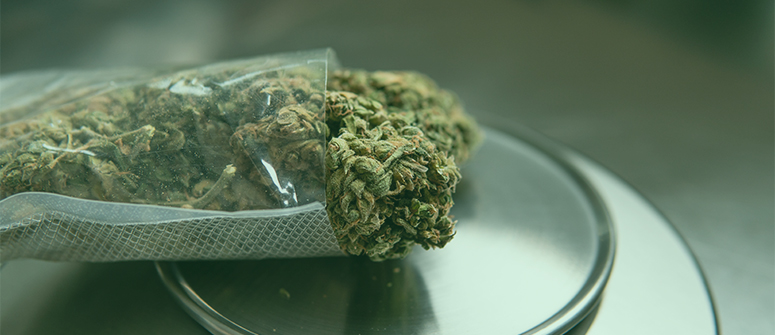
Dosing appropriately is always important when using cannabis. However, with edibles, it's even more so because they typically take a lot longer to take effect, and produce a much more extreme and prolonged high.
When you smoke a joint or hit a vape, the smoke or vapor you inhale delivers delta-9-THC to your lungs, where it is directly absorbed into the bloodstream and transported to cannabis receptors around the body. Typically, you'll feel the effects of smoking or vaping within seconds or minutes after inhaling, and the effects will peak within 30 minutes or so. Depending on the dose, as well as your sensitivity to cannabis, the high from smoking a joint or hitting a vape lasts up to around 2–3hrs.
When you ingest an edible, however, delta-9-THC is delivered to your stomach and digestive tract where it is absorbed much more slowly—which is why edibles can take anywhere from 30–90 minutes to kick in. Once absorbed via the digestive tract, some of the delta-9-THC from your edibles will enter your bloodstream, but most of it will first be metabolised by the liver to form 11-OH-THC—a version of THC that passes through the blood–brain barrier much more easily, and is also much more potent, than regular delta-9 THC.
As a result, you'll experience a substantially stronger high from an edible containing 10mg of THC than you would from smoking 10mg of THC through a joint or bong. Plus, the effects of edibles will peak at around the 2-hour mark and can last 6–12 hours in total, depending on your tolerance and the dose.
Given the intense effects of edibles, knowing your dose before chowing down on a brownie or space cake is really important to ensure a pleasant experience. The effects of edibles can be a lot of fun for recreational users, and provide effective relief to medical patients. For inexperienced users or when experienced unexpectedly, however, an edible high can be very unpleasant and overwhelming.
The potency of edibles can vary greatly
If you're lucky enough to live in an area where edibles are sold legally, you'll likely have access to edibles with clear labels describing the amount of cannabinoids they contain, as well as dosing guidelines. As mentioned earlier, most legal markets consider 10mg of THC a standard dose for edibles, but dispensaries and other retailers sometimes sell packs of edibles containing multiple doses. In California or Colorado, for example, it is common for edible products to contain up to 100mg of THC, split into multiple doses.
If you live in an unregulated market, however, you won't have this luxury. Here, you either buy edibles from a (hopefully) trustworthy source or you make them yourself, in which case you'll be left estimating the potency of your final product, as you have no way to know the exact THC content of the flower you use to make your edibles (see more below).
Dosing cannabis edibles — Top factors to consider
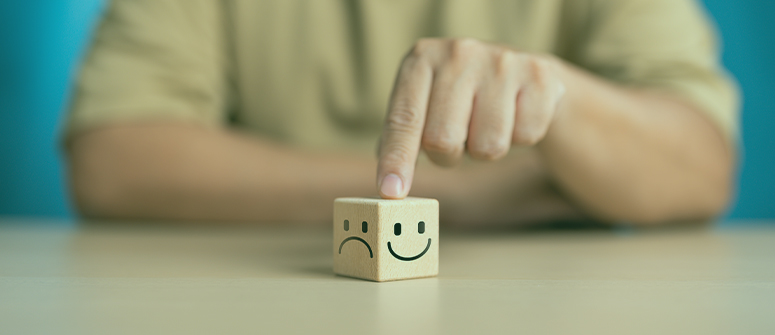
Now that you understand how edibles work, it's time to start looking at how to go about finding the right edible dose. In general, we recommend considering the following factors when determining your ideal dose.
Your body and tolerance
Your weight and metabolism, whether or not you've eaten, and your tolerance for THC are all factors that can have a big impact on your experience with edibles. Rather than simply taking a 10mg edible dose because that's what's considered "normal" in legal markets, we invite you to reflect on the uniqueness of your body and tailor your dose accordingly.
If you're new to edibles, for example, we always recommend you start with a micro or low dose (1–5mg THC), observe how you feel after 90 minutes, and take a second dose if need be. The same rings true for users who have experimented with edibles before and noticed that they have a fast metabolism and are a little more sensitive to the effects of edible cannabis than others.
Remember, you can always "add on" THC but you can't take it off—once it is in your system, the only thing you can do is wait for its effects to pass.
Your mental state
While cannabis is often touted as safe and non-addictive, there is a definite link between cannabis use and mental health issues in some people. Unfortunately, we don't yet know the exact implications of this link, but there is solid evidence to suggest that cannabis use can affect brain development in young people, and that cannabis use may be linked to conditions like anxiety disorders and depression.
Research also shows that cannabis, especially highly potent cannabis flower, edibles, or concentrates, can cause psychosis in some people. As cannabis and its derivatives become more potent, the risk of becoming dependent on or addicted to THC also increases.¹
If you're concerned about your mental health, always talk to a healthcare professional before experimenting with substances such as cannabis, especially highly potent forms such as edibles.
Your setting
Set (i.e. mental state) and setting are two concepts that have profound effects on our experience with drugs. If you're thinking about taking edibles, especially for the first time, it's a good idea to do so in a setting that's inviting and comforting, such as at home, out in nature, or with close friends. If you're a recreational user, take the time to set up a nice environment for yourself where you can really enjoy the effects of the brownie, cookie, or gummy you're about to imbibe.
If you're a medical patient who needs all-day relief, on the other hand, consider how your setting might affect your experience, and adjust your dose accordingly. If you want to medicate before or while at work, consider taking a smaller-than-normal dose so you still experience relief from your symptoms, but don’t feel so intoxicated that you're unable to focus on your responsibilities.
The kind of edible you're taking (store-bought vs homemade)
Most legal cannabis markets are taking measures to ensure the edibles sold via dispensaries and other retailers are consistent and of high quality. Moreover, most legal cannabis markets have strict rules regarding the labelling of edibles, which makes it much easier for end users to control their dose.
Homemade edibles, however, are a completely different story. Unless you're able to buy tested and clearly labelled cannabis flower from a dispensary or pharmacy, there's simply no way of knowing how much THC is going into the brownies, cookies, or other edibles you're making. How effectively you decarboxylate your flower and extract it into your cooking oil or butter also affect the potency of whatever you're making. Combined, these factors make it very difficult to properly dose homemade cannabis edibles.
In general, we recommend taking homemade edibles like brownies and cookies in moderation—try eating half of a regular serving and wait 90 minutes to gauge how you're affected. Again, remember that you can always add on but never take off. Below, we'll take a closer look at how to determine the dose of homemade cannabis edibles. It won’t be perfect, but you can get pretty close to the truth.
How to determine the THC dose of edibles
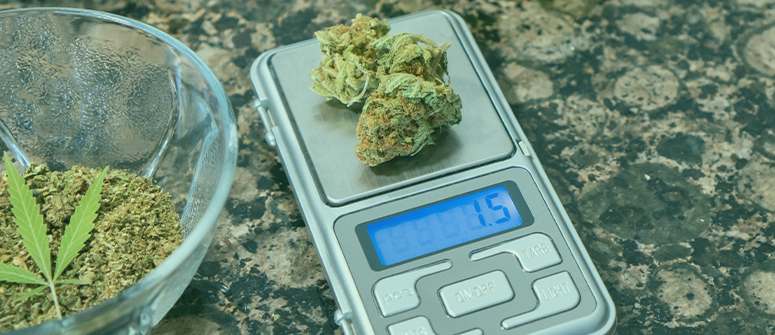
Knowing how much THC is in your homemade edibles is tricky, and it only works if you have an idea of how much THC is in the dry flower or extract you use to infuse your edibles. Without knowing this information, it's impossible to properly dose them.
To correctly determine the dose of any edible recipe, use the following formula:
nr. of servings × 10mg (standard edible THC dose) = total amount of THC that should go into your recipe
If you're following a brownie recipe that makes 16 brownies, for example, this formula would look like:
16 × 10mg = 160mg
To find out how much THC is in your flower, simply multiply the THC percentage of your bud (as a decimal) by 1000 to find out how many milligrams of THC are in 1g of bud. For flower with 16% THC, for example, the formula would look like:
0.16 (THC %) × 1000mg (1g of flower) = 160mg
Now you can calculate how many grams of weed you need to properly infuse any recipe based on the amount of servings that recipe makes.
If you're new to making edibles, arguably the easiest way to go about dosing is to first find a good recipe for whatever type of edible you want to make. Brownies are a great place to start as they are easy to whip up and super delicious. Once you've found a good brownie recipe, take note of how many servings it makes, and multiply that number by 10 to find out how many mg of THC you'll want to infuse into your brownies. Say your recipe makes 16 servings; you'll want to use 160–240mg of THC for the recipe to get 16 standard doses (i.e. 10–15mg).
Next, you'll want to source some dry flower to infuse your recipe. If you live in an area where weed is legal, this is as simple as going to a dispensary or pharmacy. Make sure that the product you buy is clearly labelled with the amount of cannabinoids it contains, as you'll need this information to know how much bud to include in your recipe. Per our example, if your flower contains 16% THC, you'll want to use 1–1.5g of weed to infuse a recipe that produces 16 servings.
After decarbing your weed (which is vital for turning THCA into THC), use it to infuse all of the butter/oil in your brownie recipe. Remember that infusing butter takes time, and you'll usually lose around 25% of the butter to evaporation, so it helps to use 1.25 times the amount of butter described in the recipe.
Final tips for consuming a suitable edible dose
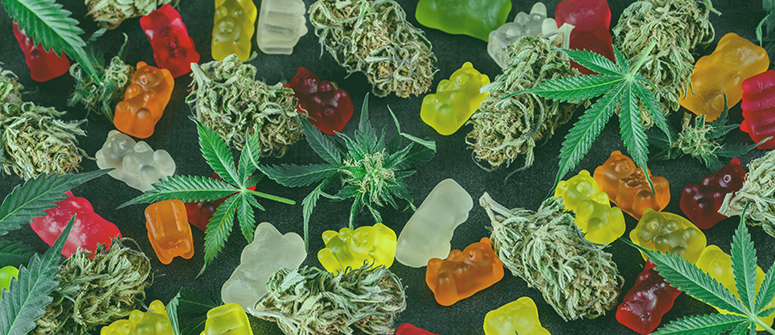
Now that you know how edibles work in the body as well as how to dose them, here are a few final tips to help you ensure a fun and safe experience every time:
- Use high-quality ingredients: Your edibles are only going to be as good as the ingredients you put into them. This goes for both the cannabis (we always recommend using organic weed with reliable information regarding its cannabinoid levels) as well as the other ingredients.
- Mix well: To ensure that all servings are equally potent, mix your infused oil or butter well with the other ingredients, and distribute the mix evenly throughout whatever dish you’re using to bake or cook your edible.
- Be accurate when measuring your weed and other ingredients.
- Divide your edibles evenly: When it's finally time to plate up your edibles, make sure you divide your servings evenly. The most accurate way to do this is to weigh your servings using a kitchen scale.
- Start low and go slow: This is, without a doubt, the golden rule to an enjoyable edible experience. Thankfully, if you do happen to get overwhelmed by the effects of an edible, we have some tips for coming back down to Earth.
Calculating THC doses of homemade edibles: No exact science
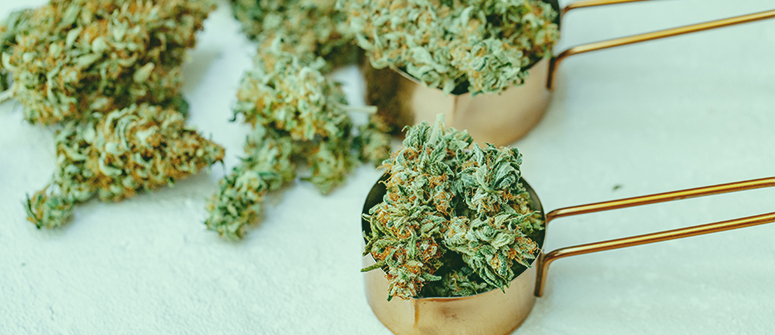
Edibles offer a unique way to enjoy the effects of cannabis. By delivering THC into the bloodstream via the digestive tract and the liver, they produce prolonged, profound effects that are loved by recreational users and medical cannabis patients alike. Proper dosing, however, is key to ensuring a safe and enjoyable experience with weed edibles.
References:
Stuyt E. The Problem with the Current High Potency THC Marijuana from the Perspective of an Addiction Psychiatrist. Mo Med. 2018 Nov-Dec;115(6):482-486. PMID: 30643324; PMCID: PMC6312155. https://www.ncbi.nlm.nih.gov/pmc/articles/PMC6312155/
.jpg)
.jpg)

.jpg)
